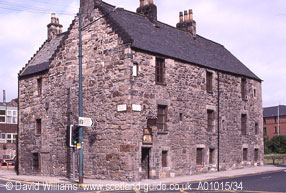Provand`s Lordship is the city`s oldest house and is now one of Glasgow`s museums, exhibiting furniture and living conditions in medieval times. It was originally built in 1471 by Bishop Andrew Muirhead to house the chaplain of the nearby St Nicholas Hospital. Glasgow Cathedral was served by numerous clergy who lived in manses around the precinct and received their financial support (or `prebend`) from various surrounding parishes. This house was supported by the lands of Provan (to the east of here) so the canon living here was called the Lord of Provan and the house became known as Provand`s Lordship. His country house was Provan Hall.
Much of the
building`s exterior is medieval, with rubble-built walls and traditional
crow-stepped gables. However, the western extension was added in the seventeenth
century; the windows are probably seventeenth or eighteenth century in
origin and the northern end was altered in the nineteenth century. There
are few external decorations but there is an old sundial on the southern
gable. In 1670 it was extended by the tailor who then occupied the building;
since then it has had many functions, including accommodating the local
hangman in a lean-to which was built for him. It has also served as an
alehouse and as a barber`s shop. Inevitably, the building`s fabric deteriorated
over the centuries but it was `saved` early in the twentieth century and,
in 1970, it was taken over as a city museum.
The main
part of the building has three floors, each with three rooms, and these
contain many interesting items of furniture dating from the sixteenth,
seventeenth and eighteenth centuries; some of these were originally collected
by Sir William Burrell. There are also numerous paintings (mainly portraits),
some stained-glass windows and various interesting bits of `Glaswegiana`.
On the first floor is a reconstruction of the furnished chamber of Cuthbert
Simson who lived here as a chaplain at the beginning of the sixteenth
century. Tall visitors should take care when entering the rooms as the
doorways` stone lintels are very low!
Behind the house is the St Nicholas Garden (1995). This contains a Physic Garden with herbs and other plants which were used in fifteenth-century medicine. Within it is the Knot Garden whose shape is based on an ancient Celtic knot design. Thirteen grotesque heads are displayed on the walls of the surrounding cloister. These are the well-known Tontine Faces, many of which were originally part of the external decoration of the Tontine Building which was erected around 1760 beside the Tolbooth at Glasgow Cross.
This article is based on the guidebook "The Glasgow Guide".

Provand`s Lordship is the oldest secular building in Glasgow.
The original ten faces were sculpted by Mungo Naismith and were supposed to be based on particular people in Glasgow. The faces were removed around 1867 and the story of their disappearance, recovery, re-use, loss and so on is a delight (or frustration) to local historians; to make matters even more complex, new faces have been added at various times! Three sculpted coats of arms are also on display at the north-western corner of the garden. The one on the left has two shields: the upper has the arms of the Earl of Argyll on his marriage to Elizabeth Stewart and the lower celebrates the marriage of a Campbell to a Stewart. The middle sculpture shows the arms of Scotland and comes from the mansion of Silvercraigs. Finally, the Glasgow coat of arms on the right came from the Old College in High Street.
An open garden stands farther to the west (and beyond the museum`s perimeter wall). Within it is a bronze three-dimensional plan of the Cathedral area, a finely-carved sundial and an orchard.